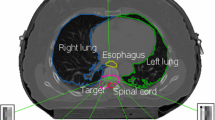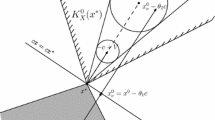Abstract
Several algorithms already exist for solving the uncapacitated facility location problem. The most efficient are based upon the solution of the strong linear programming relaxation. The dual of this relaxation has a condensed form which consists of minimizing a certain piecewise linear convex function. This paper presents a new method for solving the uncapacitated facility location problem based upon the exact solution of the condensed dual via orthogonal projections. The amount of work per iteration is of the same order as that of a simplex iteration for a linear program inm variables and constraints, wherem is the number of clients. For comparison, the underlying linear programming dual hasmn + m + n variables andmn +n constraints, wheren is the number of potential locations for the facilities. The method is flexible as it can handle side constraints. In particular, when there is a duality gap, the linear programming formulation can be strengthened by adding cuts. Numerical results for some classical test problems are included.
Similar content being viewed by others
References
S. Ahn, C. Cooper, G. Cornuejols and A. Frieze, “Probabilistic analysis of a relaxation for thek-median problem,”Mathematics of Operations Research 13 (1988) 1–31.
S. Busovaca, “Handling degeneracy in a nonlinearl 1 algorithm,” Technical Report CS-85-34, Department of Computer Science, University of Waterloo (Waterloo, Ont., 1985).
P.H. Calamai and A.R. Conn, “A projected Newton method forl p norm location problems,”Mathematical Programming 38 (1987) 75–109.
D.C. Cho, M.W. Padberg and M.R. Rao, “On the uncapacitated plant location problem II: Facets and lifting theorems,”Mathematics of Operations Research 8 (1983) 590–612.
A.R. Conn, “Nonlinear programming, exact penalty functions and projection techniques for nonsmooth functions,” in: P.T. Boggs, R.H. Byrd and R.B. Schnabel, eds.,Numerical Optimization 1984 (SIAM, Philadelphia, 1985) pp. 1–25.
G. Cornuejols, M.L. Fisher and G.L. Nemhauser, “Location of bank accounts to optimize float: An analytic study of exact and approximate algorithms,”Management Science 23 (1977) 789–810.
G. Cornuejols, G.L. Nemhauser and L.A. Wolsey, “The uncapacitated facility location problem,” to appear in: R.L. Francis and P. Mirchandani, eds.,Discrete Location Theory (Wiley, New York, 1989).
G. Cornuejols and J.-M. Thizy, “Some facets of the simple plant location polytope,”Mathematical Programming 23 (1982) 50–74.
M.A. Efroymson and T.L. Ray, “A branch and bound algorithm for plant location,”Operations Research 14 (1966) 361–368.
D. Erlenkotter, “A dual-based procedure for uncapacitated facility location,”Operations Research 26 (1978) 992–1009.
R.S. Garfinkel, A.W. Neebe and M.R. Rao, “An algorithm for the M-median plant location problem,”Transportation Science 8 (1974) 217–236.
M. Grötschel and M.W. Padberg, “Polyhedral theory and polyhedral computations,” in: E. L. Lawler, J. K. Lenstra, A.H.G. Rinnooy Kan and D.B. Shmoys, eds.,The Traveling Salesman Problem (Wiley, New York, 1985) pp. 251–360.
M. Guignard, “Fractional vertices, cuts and facets of the simple plant location problem,”Mathematical Programming Study 12 (1980) 150–162.
M. Guignard and K. Spielberg, “Algorithms for exploiting the structure of the simple plant location problem,”Annals of Discrete Mathematics 1 (1977) 247–271.
R.L. Karg and G.L. Thompson, “A heuristic approach to solving traveling salesman problems,”Management Science 10 (1964) 225–248.
M. Körkel, “On the exact solution of large-scale simple plant location problems,” Technical Report 032TB22e, Forschungsinstitute beim FTZ (Darmstadt, 1987).
P. Krolak, W. Felts and G. Marble, “A man-machine approach towards solving the traveling salesman problem,”Communications of the ACM 14 (1971) 327–334.
J.G. Morris, “On the extent to which certain fixed-charge depot location problems can be solved by LP,”Journal of the Operational Research Society 29 (1978) 71–76.
J.M. Mulvey and H.L. Crowder, “Cluster analysis: An application of Lagrangian relaxation,”Management Science 25 (1979) 329–340.
S.C. Narula, U.I. Ogbu and H.M. Samuelsson, “An algorithm for thep-median problem,”Operations Research 25 (1977) 709–713.
C.S. ReVelle and R.S. Swain, “Central facility location,”Geographical Analysis 2 (1970) 30–42.
L. Schrage, “Implicit representation of variable upper bounds in linear programming,”Mathematical Programming Study 4 (1975) 118–132.
K. Spielberg, “Algorithms for the simple plant-location problem with some side conditions,”Operations Research 17 (1969) 85–111.
Author information
Authors and Affiliations
Rights and permissions
About this article
Cite this article
Conn, A.R., CornuéJols, G. A projection method for the uncapacitated facility location problem. Mathematical Programming 46, 273–298 (1990). https://doi.org/10.1007/BF01585746
Received:
Revised:
Issue Date:
DOI: https://doi.org/10.1007/BF01585746




